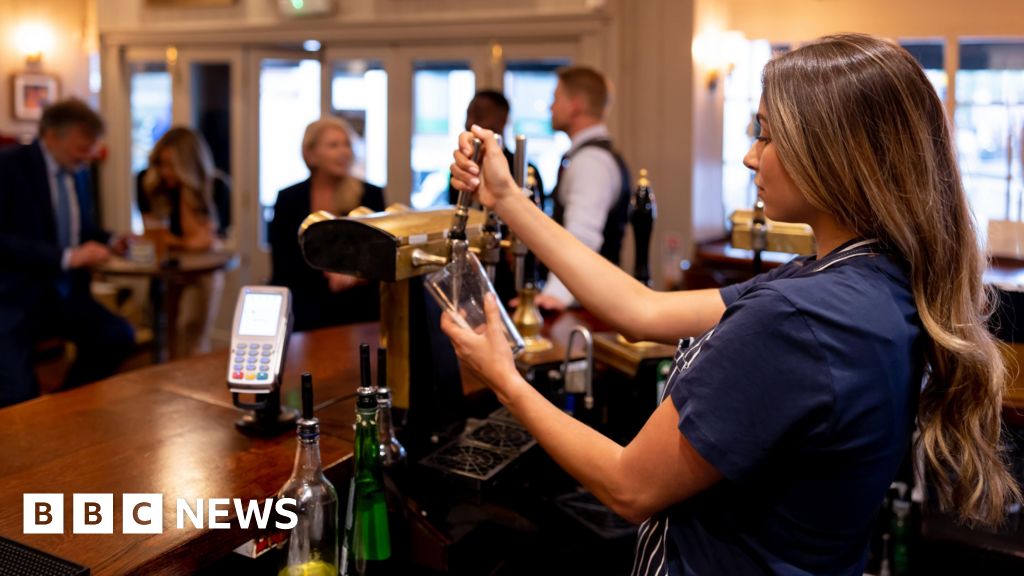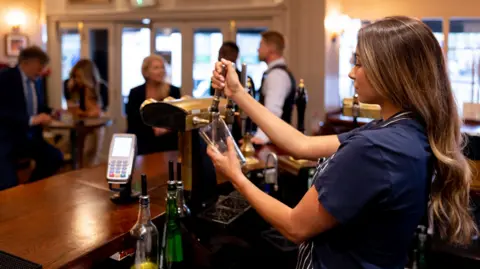Business
Half of UK job losses in hospitality, say bosses

BBC Business reporter
 Getty Images
Getty ImagesLeaders in the hospitality industry have said that more than half of the UK’s job losses since the last budget have come from their sector.
Job losses in restaurants, bars, pubs and hotels total around 89,000 since last October, according to UKHospitality analysis of Office for National Statistics data.
The group said higher taxes announced by Chancellor Rachel Reeves in the Autumn Budget had disproportionately slowed down investment and hiring, adding that “urgent action” was needed to cut business rates and VAT.
The Treasury said it was helping pubs, cafes and restaurants by extending business rates relief and cutting the cost of licensing so more establishments could offer al fresco dining.
UKHospitality, which has around 750 members and represents more than 123,000 venues, said the sector accounted for 53% of all job losses in the UK.
About 4.1% of all jobs in the sector had been lost and the number could reach 100,000 by the time of the next budget, the group added.
Kate Nicholls, chair of UKHospitality, said the numbers were “staggering”.
“What we’re seeing at the moment is a third of businesses cutting their opening hours, one in eight saying that they’re closing sites, and 60% saying they are cutting staff numbers,” Ms Nicholls told BBC Radio 4’s Today programme.
“We could see very significant business closures and failures and accelerated job losses going in to next year, and it could be as high as we saw during the Covid period.
“The sheer scale of costs being placed upon hospitality has forced businesses to take agonisingly tough decisions to cut jobs – with part-time and flexible roles often those most at risk.”
Mark Wrigley, who owns Atlas bar in Manchester, told the BBC he had stopped paying himself in order to save costs.
“We probably generate £300,000 or £400,000 for government, from this one business, and yet I get nothing from it,” Mark Wrigley told BBC’s Breakfast.

An increase to the minimum wage, which came in this April, means that bosses have had to pay workers more in an environment where other costs, such as ingredients and energy bills, are also rising.
Employers are also now paying higher National Insurance contributions, meaning it costs more to employ someone.
These higher business costs coincide with the rising cost of living, which means people are going out to eat less to save on costs, lowering sales and profits for leisure industries.
Prices in the UK rose by 3.8% in the year to July, driven mainly by a jump in the price of air fares and food.
It means inflation is at its highest level since January 2024 and still far above the Bank of England’s target of 2%, according to the ONS.
In its last set of jobs data, looking at the period between May and July, the ONS said job openings had continued to fall, with fewer people on the payroll.
“The number of employees on payroll has now fallen in 10 of the last 12 months, with these falls concentrated in hospitality and retail, said Liz McKeown, director of economic statistics at the ONS.
Job openings fell by 5.8% to 718,000 between May and July across nearly all industries.
The ONS said there was evidence that some firms may not be recruiting new workers or replacing people who have left.
A spokesperson for the Treasury said: “Pubs, cafes and restaurants are vital to local communities, that’s why we’re cutting the cost of licensing, helping more pubs, cafes and restaurants offer pavement drinks and al fresco dining, and extending business rates relief for these businesses – on top of cutting alcohol duty on draught pints and capping corporation tax.”
Business
Private sector data: Over 2 lakh private companies closed in 5 years; govt flags monitoring for suspicious cases – The Times of India

NEW DELHI: The government on Monday said that over the past five years, more than two lakh private companies have been closed in India.According to data provided by Minister of State for Corporate Affairs Harsh Malhotra in a written reply to the Lok Sabha, a total of 2,04,268 private companies were shut down between 2020-21 and 2024-25 due to amalgamation, conversion, dissolution or being struck off from official records under the Companies Act, 2013.Regarding the rehabilitation of employees from these closed companies, the minister said there is currently no proposal before the government, as reported by PTI. In the same period, 1,85,350 companies were officially removed from government records, including 8,648 entities struck off till July 16 this fiscal year. Companies can be removed from records if they are inactive for long periods or voluntarily after fulfilling regulatory requirements.On queries about shell companies and their potential use in money laundering, Malhotra highlighted that the term “shell company” is not defined under the Companies Act, 2013. However, he added that whenever suspicious instances are reported, they are shared with other government agencies such as the Enforcement Directorate and the Income Tax Department for monitoring.A major push to remove inactive companies took place in 2022-23, when 82,125 companies were struck off during a strike-off drive by the corporate affairs ministry.The minister also highlighted the government’s broader policy to simplify and rationalize the tax system. “It is the stated policy of the government to gradually phase out exemptions and deductions while rationalising tax rates to create a simple, transparent, and equitable tax regime,” he said. He added that several reforms have been undertaken to promote investment and ease of doing business, including substantial reductions in corporate tax rates for existing and new domestic companies.
Business
Pakistan’s Textile Exports Reach Historic High in FY2025-26 – SUCH TV

Pakistan’s textile exports surged to $6.4 billion during the first four months of the 2025-26 fiscal year, marking the highest trade volume for the sector in this period.
According to the Pakistan Bureau of Statistics (PBS), value-added textile sectors were key contributors to the growth.
Knitwear exports reached $1.9 billion, while ready-made garments contributed $1.4 billion.
Significant increases were observed across several commodities: cotton yarn exports rose 7.74% to $238.9 million, and raw cotton exports jumped 100%, reaching $2.6 million from zero exports the previous year.
Other notable gains included tents, canvas, and tarpaulins, up 32.34% to $53.48 million, while ready-made garments increased 5.11% to $1.43 billion.
Exports of made-up textile articles, excluding towels and bedwear, rose 4.17%, totaling $274.75 million.
The report also mentioned that the growth in textile exports is a result of improved global demand and stability in the value of the Pakistani rupee.
Business
Peel Hunt cheers ‘positive steps’ in Budget to boost London market and investing

UK investment bank Peel Hunt has given some support to under-pressure Chancellor Rachel Reeves over last week’s Budget as it said efforts to boost the London market and invest in UK companies were “positive steps”.
Peel Hunt welcomed moves announced in the Budget, such as the stamp duty exemption for shares bought in newly listed firms on the London market and changes to Isa investing.
It comes as Ms Reeves has been forced to defend herself against claims she misled voters by talking up the scale of the fiscal challenge in the run-up to last week’s Budget, in which she announced £26 billion worth of tax rises.
Peel Hunt said: “Following a prolonged period of pre-Budget speculation, businesses and investors now have greater clarity from which they can start to plan.
“The key measures were generally well received by markets, particularly the creation of additional headroom against the Chancellor’s fiscal rules.
“Initiatives such as a stamp duty holiday on initial public offerings (IPOs) and adjustments to the Isa framework are intended to support UK capital markets and encourage investment in British companies.
“These developments, alongside the Entrepreneurship in the UK paper published simultaneously, represent positive steps toward enhancing the UK’s attractiveness for growth businesses and long-term investors.”
Ms Reeves last week announced a three-year stamp duty holiday on shares bought in new UK flotations as part of a raft of measures to boost investment in UK shares.
She also unveiled a change to the individual savings account (Isa) limit that lowers the cash element to £12,000 with the remaining £8,000 now redirected into stocks and shares.
But the Chancellor also revealed an unexpected increase in dividend tax, rising by 2% for basic and higher rate taxpayers next year, which experts have warned “undermines the drive to increase investing in Britain”.
Peel Hunt said the London IPO market had begun to revive in the autumn, although listings activity remained low during its first half to the end of September.
Firms that have listed in London over recent months include The Beauty Tech Group, small business lender Shawbrook and tinned tuna firm Princes.
Peel Hunt added that deal activity had “continued at pace” throughout its first half, with 60 transactions announced across the market during that time and 10 active bids for FTSE 350 companies, as at the end of September.
Half-year results for Peel Hunt showed pre-tax profits jumped to £11.5 million in the six months to September 30, up from £1.2 million a year earlier, as revenues lifted 38.3%.
Peel Hunt said its workforce has been cut by nearly 10% since the end of March under an ongoing savings drive, with full-year underlying fixed costs down by around £5 million.
Steven Fine, chief executive of Peel Hunt, said: “The second half has started strongly, with the group continuing to play leading roles across both mergers and acquisitions and equity capital markets mandates.”
-

 Sports1 week ago
Sports1 week agoWATCH: Ronaldo scores spectacular bicycle kick
-

 Entertainment1 week ago
Entertainment1 week agoWelcome to Derry’ episode 5 delivers shocking twist
-

 Politics1 week ago
Politics1 week agoWashington and Kyiv Stress Any Peace Deal Must Fully Respect Ukraine’s Sovereignty
-

 Business1 week ago
Business1 week agoKey economic data and trends that will shape Rachel Reeves’ Budget
-

 Tech6 days ago
Tech6 days agoWake Up—the Best Black Friday Mattress Sales Are Here
-

 Politics1 week ago
Politics1 week ago53,000 Sikhs vote in Ottawa Khalistan Referendum amid Carney-Modi trade talks scrutiny
-

 Fashion1 week ago
Fashion1 week agoCanada’s Lululemon unveils team Canada kit for Milano Cortina 2026
-

 Tech23 hours ago
Tech23 hours agoGet Your Steps In From Your Home Office With This Walking Pad—On Sale This Week






